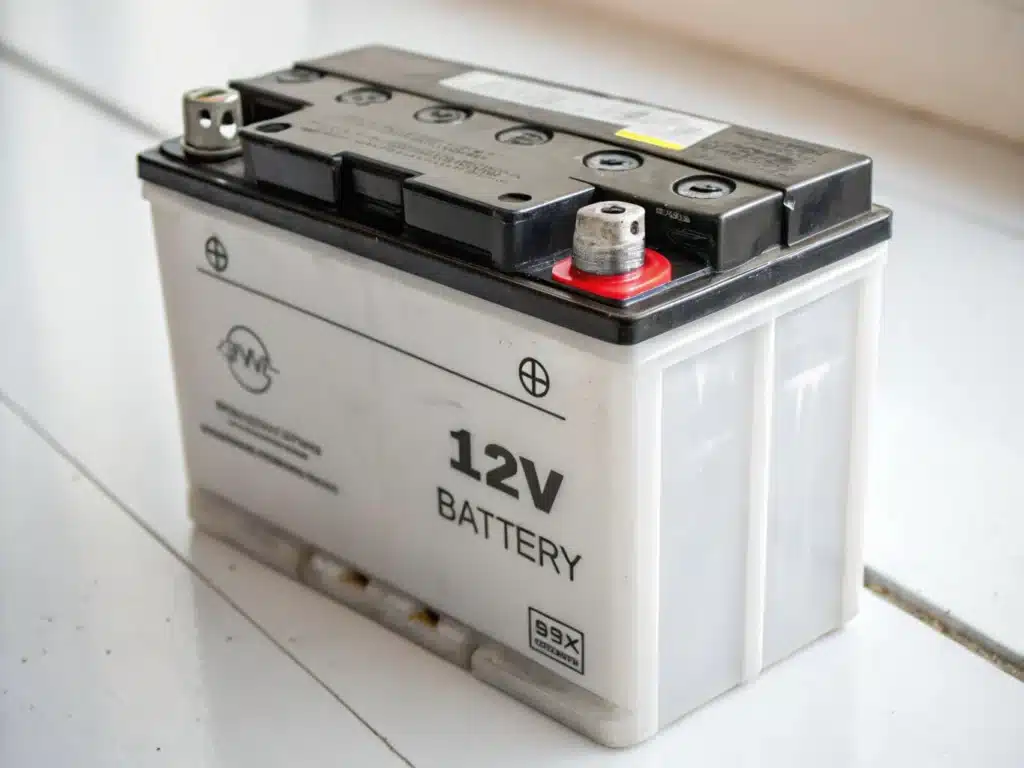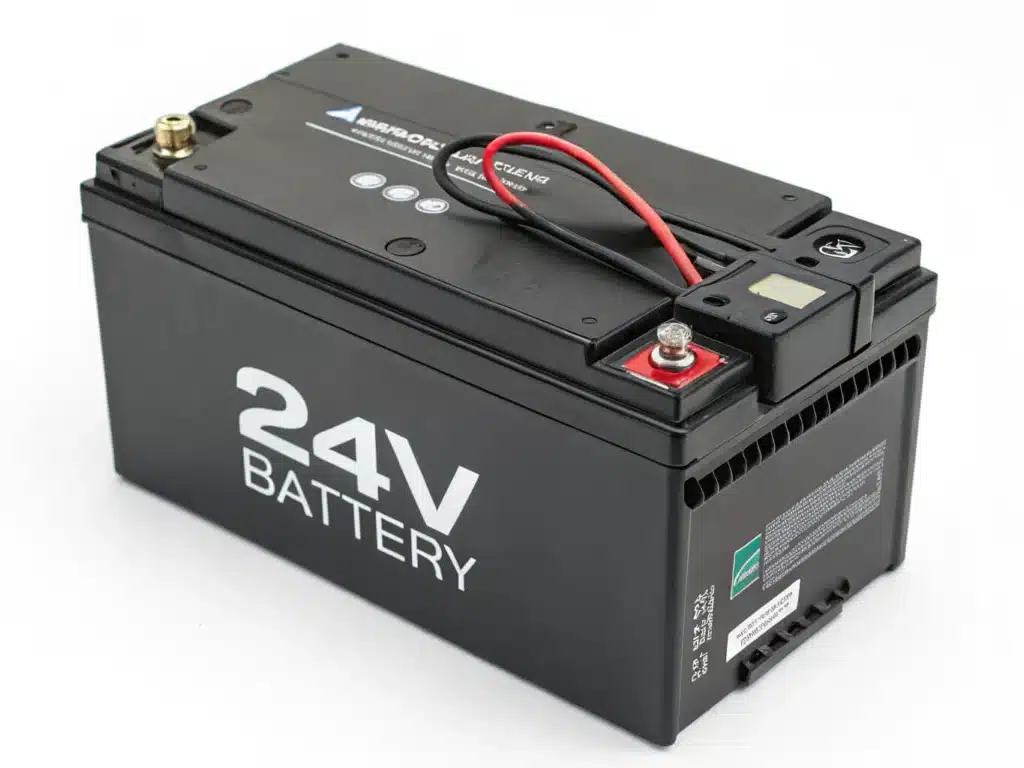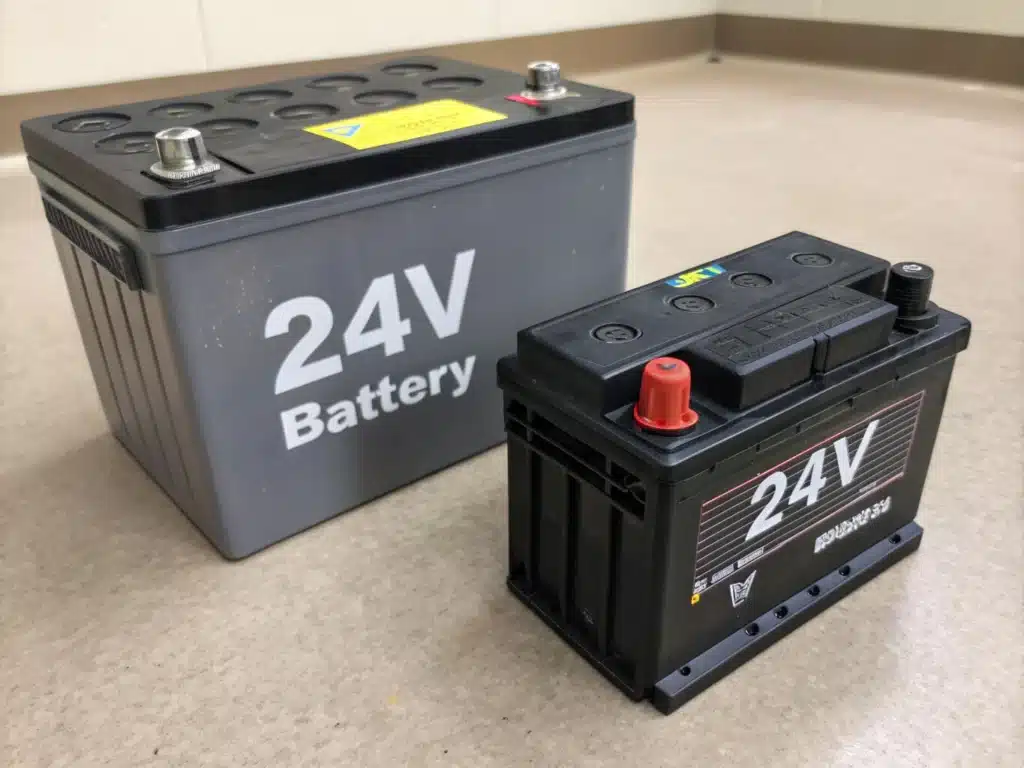When choosing between 12V vs 24V battery systems, understanding the fundamental differences can significantly impact your power system’s performance, efficiency, and cost-effectiveness. This comprehensive guide explores everything you need to know about 12V and 24V batteries to make an informed decision for your specific application.
Table of Contents
ToggleWhat is 12V battery

A 12V battery is an electrical power source that delivers a nominal voltage of 12 volts, making it the most widely adopted battery standard across multiple industries. These batteries typically consist of multiple cells connected in series—such as six 2V lead-acid cells or four 3.2V lithium cells—to achieve the 12-volt output.
What is 24V battery
A 24V battery system operates at twice the voltage of a 12V system, delivering 24 volts of electrical power. This higher voltage configuration can be achieved through connecting two 12V batteries in series or using purpose-built 24V battery units with internal cell arrangements designed for 24-volt output.

12V vs 24V battery: detailed comparison

Voltage and Current
Power formula impact: The fundamental relationship P = V × I (Power = Voltage × Current) reveals why voltage selection matters significantly:
12V Battery:
- Runs at 12 volts
- Needs more current (amps) to give the same power
- To get 1200 watts, you need 100 amps.
24V Battery:
- Runs at 24 volts (double the voltage)
- Needs less current for the same power.
- To get 1200 watts, you only need 50 amps.
Why this matters: Less current means less stress on your wires and connections. It’s like using a bigger pipe for water – less pressure needed.
Efficiency and heat
12V Systems:
- Less efficient (about 85% in high-power use)
- Create more heat because of higher current
- Waste more energy as heat in the wires
- Batteries may run hotter
24V Systems:
- More efficient (about 88-90%)
- Create less heat because current is lower
- Waste less energy in wires and connections
- Stay cooler during operation
- Last longer because of less heat stress
| Factor | 12V System | 24V System |
|---|---|---|
| Efficiency | 85% | 88-90% |
| Current Draw | High | 50% Lower |
| Heat Generation | Higher | Reduced |
| Wire Losses | Significant | Minimal |
What this means: 24V systems save energy and create less heat. This is especially important if you use a lot of power or if your batteries are in a hot location.
A 12V system pulling 100 amps gets much hotter than a 24V system pulling 50 amps for the same power.
Volume and weight
12V Systems:
- Individual batteries are smaller and lighter
- Easy to carry and install by yourself
- But you might need more batteries for high power needs
- Good for tight spaces where you install one battery at a time
24V Systems:
- Can be fewer total batteries for the same power
- Each battery might be heavier if it’s a single 24V unit
- Two 12V batteries connected together are heavier to move as a pair
- Takes up less total space in large power systems
My Personal Recommendation:
- Choose 12V if: You have limited space, need to carry batteries by hand, or have a small system under 2000 watts.
- Choose 24V if: You have help installing, want fewer total batteries, or need more than 3000 watts of power.
For most people, weight and size favor 12V for small systems and 24V for large systems.
Wiring and installation
12V Installation Characteristics:
- Requires thicker gauge wiring for high-power applications.
- More complex parallel wiring for capacity expansion.
- Higher current creates more connection stress.
24V Installation Advantages:
- Smaller diameter wiring acceptable for same power.
- Reduced installation costs for high-power systems.
- Less voltage drop over long cable runs.
I switched from a 12V lead-acid system to a 24V LiFePO4 battery in my RV project, here are the key installation precautions I learned:
- Before you start: Turn off all power and disconnect everything. Make sure your inverter and charger work with 24V. Let have all your tools ready and organized.
Safety during installation: Work in good lighting so you can see clearly. Have a helper nearby – don’t work alone. Keep metal tools away from battery terminals. Wear safety glasses and gloves.
Equipment changes needed: Replace your 12V charger with a 24V charger. Update fuses and breakers for 24V ratings. Set your battery monitor to 24V settings. Use proper wire size (I kept thick wires for extra safety).
Battery connection steps: Check that both 12V batteries have the same voltage. Connect the batteries in series carefully. Secure all connections tightly. Test everything twice with a voltage meter.
Final check: Double-check all voltages before connecting loads. Make sure all wires are secure and protected. Test the system with a small load first.
Cost
Initial Cost (What you pay first):
- 12V batteries: Usually cheaper to start
- 24V batteries: Cost more upfront
- 12V equipment: More options, lower prices
- 24V equipment: Fewer choices, higher prices
Long-term Cost (What you pay over time):
- 12V systems: Higher electricity bills due to lower efficiency
- 24V systems: Save money on electricity over time
- 12V wiring: Need thicker, more expensive wire for high power
- 24V wiring: Can use thinner, cheaper wire
Installation Cost:
- 12V: Cheaper for small systems
- 24V: Cheaper for large systems (less wire needed)
Our cost advice:
- For systems under 2000 watts: 12V is usually cheaper overall.
- For systems over 3000 watts: 24V saves money in the long run.
- Consider your budget: If you have limited money now, start with 12V.
- Think long-term: If you plan to expand your system, 24V might be better.
Applicable Scenarios
Use 12V batteries for:
- Cars and trucks (starting engines)
- Small RVs and campers
- Boats and marine equipment
- Backup power for homes
- Solar systems under 3000 watts
- Portable equipment
- DIY projects
Use 24V batteries for:
- Large RVs and motorhomes
- Commercial trucks and equipment
- Big solar power systems (over 3000 watts)
- Industrial machinery
- Golf carts and electric vehicles
- Professional installations
- Systems that run all day, every day
Conclusion
The choice between 12V and 24V battery systems isn’t about finding a universal winner—it’s about selecting the optimal solution for your specific requirements. Both voltage standards play crucial roles in our electrical ecosystem, serving different needs with distinct advantages.
12V systems excel in cost-sensitive, moderate-power applications where simplicity and compatibility are paramount. 24V systems shine in high-power, efficiency-critical applications where performance justifies the premium investment.
Ready to find your perfect battery solution? Contact us to get personalized recommendations from our battery experts. Our team will analyze your specific requirements and help you choose between 12V and 24V systems, ensuring you get the most efficient, cost-effective solution for your power needs.
